Today we’re going to discuss the repercussions to space science of Russia’s invasion of Ukraine. Some people may find this subject upsetting, and if you need to skip this episode, we understand. We’re going to take a look at Roscosmos and how space corporations and nations are imposing sanctions that impact how, when, and what we send to space.
Podcast
Show Notes
FACT SHEET: Joined by Allies and Partners, the United States Imposes Devastating Costs on Russia (The White House)
Reinventing NASA: Human Space Flight, Bureaucracy, and Politics (Roger Handberg via Google Books)
OneWeb ‘surprised’ by Russian demands over satellite launch (New Scientist)
Transcript
Normally, the Daily Space team is here to put science in your brain. Science is more than just facts and data and discoveries, however. Science, and space exploration, in particular, is a multinational effort performed by people; people who can’t explore our universe if they aren’t safe within our global society.
Today we’re going to discuss the repercussions to space science of Russia’s invasion of Ukraine. Some people may find this subject upsetting, and if you need to turn off this episode, we understand. We’ll be back next episode to focus on the latest discoveries and news of what spacecraft have launched and landed around our world.
For now, though, let’s take a look at Roscosmos, and the ways space corporations are using their resources & nations are using sanctions to support the democratically-elected government of Ukraine and the brave people who are fighting for their lives and their freedom.
A Brief History of Ukraine
Certain areas of our world have changed hands myriad times while locally rich cultures have grown. The history of Poland is taught in schools, with attention being pulled to its history of bouncing between self-rule and being governed by Prussia, Russia, and Germany.

Like Poland, the landscape of Ukraine has changed hands many times, while a unique language and culture have remained in place. First founded in 482 C.E. (Common Era), Kyiv grew as a great city of trade on the road from Scandinavia to Constantinople and survived as the capital of the Kyivan Rus’. The land was held by the Vikings in the 9th century, but it remained a center of eastern Slavic culture until overrun by the Mongols in the 1200s, just as the Russians, Turks, and many other cultures were.
Like so much of eastern Europe, the region was occupied and ruled by myriad empires over the centuries while still holding onto its language. Ukraine won independence in 1917 with the fall of the Russian Empire but was absorbed into the USSR in 1922. Then, with the collapse of the USSR in 1991, Ukraine once again became an independent nation and has grown to become a major exporter of agricultural goods and natural resources, and home to a thriving tech industry.
Things have not been smooth sailing, however. After his election in 2010, the fourth president of Ukraine, Viktor Yanukovych, worked to move Ukraine away from the European Union (EU) and closer to Russia. This included moving away from the Ukraine-European Union Association Agreement and leaving a partnership with NATO. These actions led to the Euromaidan demonstrations in 2013 and ultimately to the Parliament removing Yanukovych in 2014 and holding new elections. It also led to Russia annexing Crimea and ongoing skirmishes along the Ukrainian-Russian border, where Russian-armed separatists have fought against the EU-leaning, democratically elected leadership of Ukraine.
And, last week, the situation changed from a proxy war to an actual war, with Russia invading Ukraine from its own land and also from the nation of Belarus. In response to the ongoing military actions of the Russian military, leaders from around the world have worked together to impose economic sanctions, asset freezes, and other financial penalties on Russia. And this is where space exploration comes into play.
ExoMars: Likely Delayed From 2022 Launch
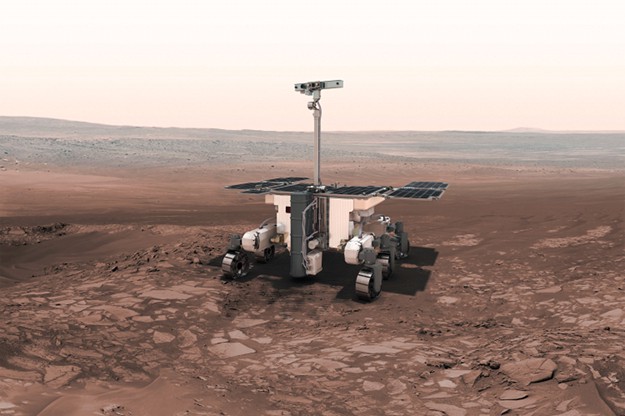
The ESA-led ExoMars mission, which includes the Rosalind Franklin Rover, had originally been scheduled to launch in March 2018 but was delayed to 2020 with plans to launch alongside NASA’s Perseverance and several other missions to Mars. Due to issues with ExoMars’s parachute design, the decision was made to hold off launch until the next launch window, which will occur later this year. This mission is a multinational collaboration led by the European Space Agency (ESA) with plans to launch the spacecraft on a Russian Proton-M rocket from the Baikonur Cosmodrome in Kazakhstan. ExoMars also relies on a Russian-built lander to deliver the rover to Mars’ surface.
According to the journal Nature: Following a meeting of ESA’s member states, the organization said on 28 February that the economic sanctions imposed by Western nations on Russia and the wider context of the war have made a 2022 launch unlikely. ESA’s director-general, Josef Aschbacher, will now analyze possible options for the mission’s way forwards.
While ESA seems determined to move forward, Lev Zelenyi, a science advisor and former president of the Space Research Institute of the Russian Academy of Science in Moscow, said: If it will not be launched this year, it will not be launched ever. Tremendous efforts of scientists, engineers, technicians of many European countries, not even speaking about Russians, will be wasted.
Unfortunately, as ESA project scientist Jorge Vago pointed out in Nature in 2016, while “in theory, Europe has made the rover and Russia has made its descent module and landing platform, there is ‘no clean line’ between the responsibilities of the two teams.”
Oleg Korablev of Russia’s Space Research Institute told Nature, “ExoMars 2022 is unprecedentedly complex in terms of interfaces,” and adapting it to another landing system and rocket would likely take more than two years, and time adds its own costs beyond what the cost of the actual machinery and design.
Stalled Collaborations: Venera-D & German Research
The Russian Venera-D Mission was also meant to be a multinational collaboration, with NASA supporting a handful of instruments for the 2029 launch. On February 26, Roscosmos Director-General Dmitry Rogozin stated: In the context of the introduction of new and the preservation of previously imposed sanctions, I consider the continued participation of the United States in the Russian project for the development and creation of an interplanetary station #ВенераД [Venera-D] inappropriate.
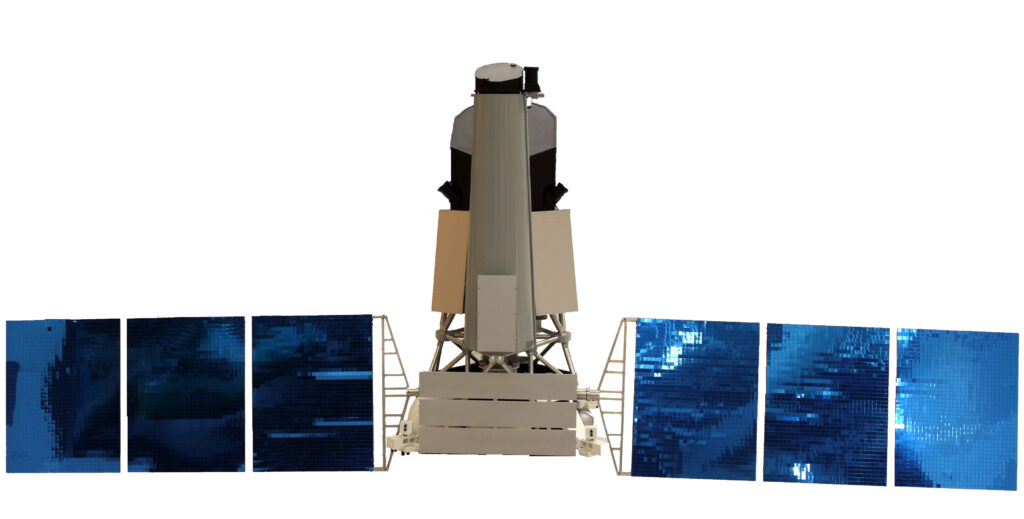
The ejection of partners hasn’t just been with NASA, however. Germany and Russia had a multi-project tête-à-tête where Germany placed the eROSITA telescope on the Spectrum-Roentgen-Gamma observatory into safe mode. According to a statement from SRG leadership at the Max Planck Institute in Garching, Germany, this action was designed to “freeze co-operation with Russia.” Max Plank’s Andrea Merloni told Science News: This is a standard, reversible, operation mode of the telescope, in which we do not take data, but keep the vital subsystems on.
While this action is reversible, it wasn’t exactly appreciated, and on March 1, the Russian News Agency TASS reported the Russian space agency intends to bill their EU collaborators for financial loss attributed to lack of opportunity. Russia has additionally said they will cease cooperation with Germany for experiments on the International Space Station (ISS), with Roscosmos tweeting on March 3: The State Corporation will not cooperate with Germany on joint experiments on the Russian segment of the ISS. Roscosmos will conduct them independently.
Roscosmos has also pulled personnel from the Soyuz launch site in French Guiana, effectively ending launches from there. A pair of Galileo navigation satellites were set to launch on a Soyuz in April, and all the hardware had been delivered. Now, the satellites will need a new ride to space.
These global issues have come to focus with one mission in particular: OneWeb.
OneWeb: Demands Left Unmet
OneWeb, the main competitor to SpaceX’s Starlink internet constellation, is experiencing a whole mess as a result of this situation. As this past week went on, it seemed that every day, Roscosmos found a new bridge to burn and impact their partnership with different western space initiatives.
They had a launch scheduled for March 5 with another 36 satellites aboard a Russian Soyuz from Baikonur. On March 2, Roscosmos posted a video on Twitter in which Director-General Rogozin threatened that the satellites would be removed from the rocket if OneWeb “does not provide a guarantee that its satellites will not be used for military purposes”.
Later that day, an article in state news agency RIA Novosti escalated this threat, saying that OneWeb had to make the promise and demanded that the U.K. government, which has sanctioned Russia, sell its shares in the company, with a nice reminder that the Soyuz is basically the only rocket which can finish OneWeb’s constellation, which is currently 75% complete. OneWeb and the British government have so far refused both of Roscosmos’ demands, and on March 2, OneWeb personnel departed the launch site.
According to an article in Vedomosti on March 3 (Moscow time), Rogozin said in an interview on the Russia-24 TV channel that if they do not receive a guarantee from OneWeb and its partners “by 9:30 pm on March 4th, the rocket will be removed from the launch and the satellites sent to the assembly and testing building”. He went on to say that the only real guarantee that OneWeb will only be used for civilian purposes is the withdrawal of the British Government shareholders and that if that doesn’t happen they “will not accept any guarantees”.
OneWeb, of course, cannot provide such a guarantee since they are a company that sells its services to customers, some of whom may resell it, and thus the military may be able to use the service without OneWeb being fully aware of the fact.
In one of the more bizarre twists of this episode, after demanding these concessions Roscosmos proceeded to remove the flags of multiple partners from the rocket. Gone were the U.S., U.K., and Japanese flags while the Indian flag remained. This divide is consistent with what nations are and are not sanctioning Russia at this time.
OneWeb On Hold
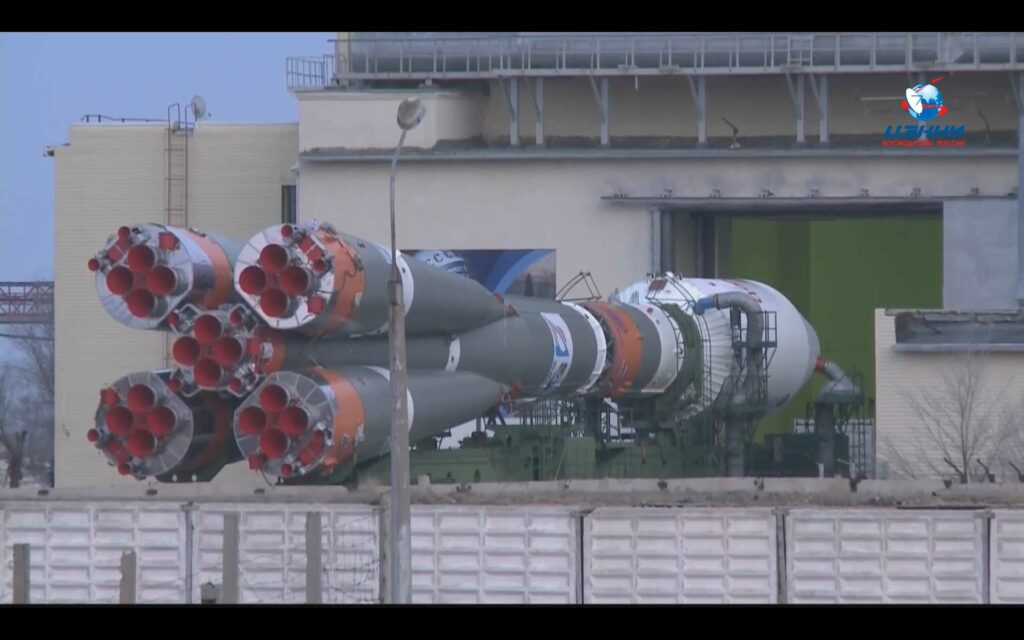
On March 3, OneWeb announced, “The Board of OneWeb has voted to suspend all launches from Baikonur”. On March 4, Roscosmos streamed the removal of the Soyuz-2.1b rocket from launch site 31 and its return to the assembly and test facility. In a tweet, Rogozin calls attention to the addition of the Latin letter V to multiple of the Baikonur structures and vehicles. This symbol, which doesn’t exist in the Cyrillic alphabet, is being used to mark Russian forces entering Ukraine from the North.
As of recording, it is not known what is going to happen to the OneWeb satellites themselves, but we do know what is going to happen to the money that OneWeb paid for the launches. According to the BBC, Rogozin has already stated that money received in exchange for Soyuz rockets will not be given back. He said, “Due to force majeure circumstances that have arisen as a result of the aggressive policy of the West and the sanctions that are applied against Russia, this money will remain in Russia.”
It should be noted that while the term ‘force majeure’ generally refers to extraordinary events that are beyond the control of parties to a contract, such as wars, strikes, riots, crimes, epidemics, for the aggressor in a war to claim force majeure is a bit hypocritical.
This situation has severe business consequences for OneWeb. It will probably take about two years to find a new launcher, during which time SpaceX’s Starlink will be fully operational and likely dominate the market. The financial implications to OneWeb don’t look good.
Future Engine Issues for Atlas & Antares
From failing to launch other nations’ spacecraft, Roscosmos moved on to trying to harm other nations’ – specifically the U.S.’s – ability to launch their own rockets. On March 3, Roscosmos’s Dmitry Rogozin told Russian State Media, “In a situation like this, we can’t supply the United States with our world’s best rocket engines. Let them fly on something else, their broomsticks, I don’t know what.”
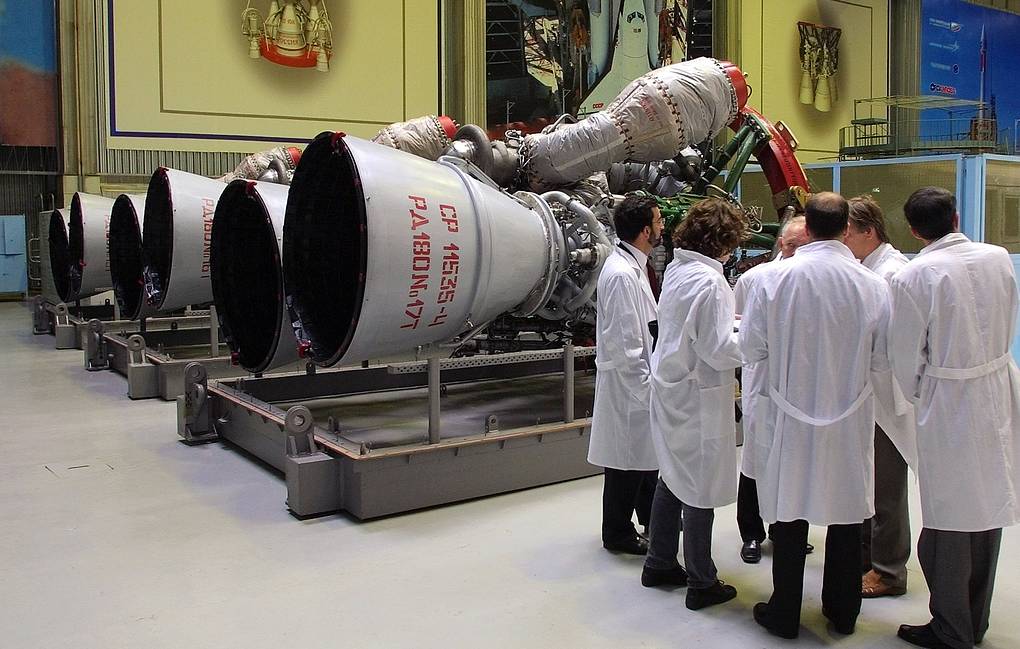
Here, Rogozin is referring to the Russian-made RD-180 engines used on the United Launch Alliance Atlas V rockets, and the related RD-181 engines on the Northrop Grumman Antares rocket. Roscosmos will no longer supply or service engines. Luckily, procuring the Atlas V’s RD-180 engine is not an issue because United Launch Alliance has already purchased and stockpiled all the engines they need for the remaining launches at their factory in the U.S., according to the company CEO, Tory Bruno, on Twitter.
While the Atlas V rocket may be in a good place, the Northrop Grumman Cygnus vehicle may be less lucky. This spacecraft launches on the Antares rockets, and the Antares first-stage tank is manufactured in Ukraine while the first-stage engines come from Russia. Cygnus can and has launched on Atlas V rockets, but all of the remaining Atlas V rockets have been sold. With adaptation, Cygnus can launch on other rockets, such as Falcon 9, but it would take some time to adapt it and find a booster and slot in SpaceX’s launch manifest.
Not being able to launch Cygnus is somewhat problematic. The U.S. has an option to perform boosts of the International Space Station with the Northrop Grumman Cygnus resupply vehicle. And boosting the ISS may become an issue.
The International Space Station: Our Last, Best Hope for Peace
One of the most oft-pursued ways to build international alliances is through international collaborations. In 1989 and 1991, I traveled to the USSR as part of first a People-to-People student exchange to study astronomy for one month, and then later as part of a six-month peace project where two of us interned at the Soviet 6-meter while a suite of Soviet students came to be associated with the Harvard-Smithsonian Astronomical Observatory. The goal was peace through science.
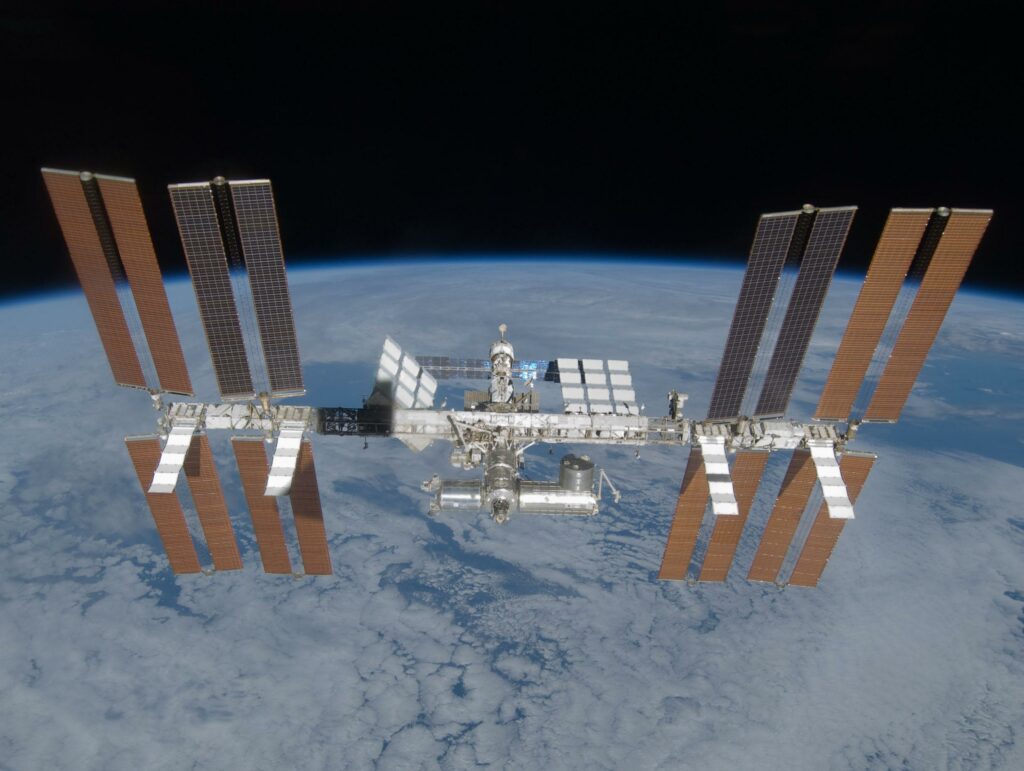
With the fall of the Soviet Union, the desire to build peace through collaboration only grew, as researchers on both sides realized how much more could be done together, and politicians signed onto their dreams. From collaboration on Mir to the shared construction of the ISS; NASA and Roscosmos have worked hard to make a permanent platform for research and education a reality. There are other partners: notably Canada, JAXA, and ESA. These are all agencies from nations sanctioning Russia today.
The Director-General of Roscosmos, Dmitry Rogozin, posted a tweet thread reminding the United States of Russia’s key role in managing the International Space Station and the possible impacts of the sanctions on the continued safe operation of the ISS in Earth orbit.
Rather than describe what he said, I’m going to read the auto-translated tweets:
“This is how you already do it by limiting exchanges between our cosmonaut and astronaut training centers. Or do you want to manage the ISS yourself? Maybe President Biden is off-topic, so explain to him that the correction of the station’s orbit, its avoidance of dangerous rendezvous with space garbage, with which your talented businessmen have polluted the near-Earth orbit, is produced exclusively by the engines of the Russian Progress MS cargo ships. If you block cooperation with us, who will save the ISS from an uncontrolled deorbit and fall into the United States or Europe? There is also the option of dropping a 500-ton structure to India and China. Do you want to threaten them with such a prospect? The ISS does not fly over Russia, so all the risks are yours. Are you ready for them? Gentlemen, when planning sanctions, check those who generate them for illness.”
This tweet thread has been read by many as a threat, and at this time, many of us are closely watching the evolution of the situation.
At the moment, the U.S. is not completely dependent on Russia for sending astronauts to the ISS and back because of SpaceX’s Crew Dragon. However, one American astronaut, Mark Vande Hei, rode up and is slated to return to Earth on a Soyuz spacecraft next month. In previous geopolitical incidents, the two countries have still cooperated peacefully in space. As of February 28, NASA’s Kathy Leuders said ISS operations remained normal.
The two segments of the ISS are dependent on each other for proper functioning. The entire point of the ISS project was to improve relations between the U.S. and Russia after the fall of the USSR. The Russian segment provides all of the propulsion and some attitude control and life support, while the U.S. segment provides life support, electrical power, communications, and attitude control without thrusters.
And there is the issue of keeping the ISS in a solid orbit. The station has to be regularly boosted due to drag from the Earth’s atmosphere. The U.S. has an option to perform boosts with the Northrop Grumman Cygnus resupply vehicle, one of which is currently attached to the station. However, it can’t do as much of a boost because the only place the Cygnus attaches to the ISS is on the nadir, or Earth-facing side, of the ISS. The Progress-MS resupply spacecraft which does most of the boost maneuvers docks on the long axis of the ISS at the rear port of the Zarya module, which is a more effective place to do boosts.
If the Russians stop boosting the ISS’s orbit, it won’t be a problem for close to two years, providing engineers time to come up with a solution. The U.S. constructed an Interim Control Module in the late 90s as a backup in the event of a problem with the Zarya module, but after Zarya launched successfully, the backup was mothballed. If needed, it is estimated it will take at least two and a half years to pull it out of mothballs and launch it.
Watching Twitter for Updates

Throughout this episode, you have heard one name said over and over: Dmitry Rogozin. The leaders of space agencies aren’t always staid individuals driven by logic – they are humans. They can be politicians, scientists, bottom-line motivated businessmen, and occasionally retired astronauts or engineers.
Dmitry Rogozin is a soldier turned politician who has been also called a Russian Oligarch and was one of the individuals sanctioned by name in 2014 after the annexation of Crimea. He has been the Director-General of Roscosmos since 2018. While Roscosmos has been most visibly active with commercial and governmental rockets for the past several years, in recent days, Rogozin has been reminding us of the ballistic missiles that share so much technology with orbital rockets.
And he’s been reminding us of his military background: one that includes fighting in the Transnistria war against Moldovan forces. Rogozin is extremely active on Facebook and Twitter, and many of us are now watching to see what Rogozin posts and how he changes his profile to better guess the future of space exploration. It is with some dismay that we note his Twitter profile picture recently changed from a rocket launch to military missiles.
And the World Comes Together to Call for Science
For now, there appears to be a largely shared view that through swift and severe sanctions, Russia can be swayed to exit Ukraine. In a statement by the G7 science academies, the science communities stated:
The unprovoked attack against Ukraine, a democratic and independent country, is a blatant violation of international law and of the core values of humanity. The Russian invasion is an assault on the fundamental principles of freedom, democracy, and self-determination, which provide the basis for academic freedom and opportunities for scientific exchange and cooperation.
In this dark hour, our thoughts and deepest sympathy are with the people of Ukraine. We are determined to support the National Academy of Sciences of Ukraine. We stand in solidarity with the scientific community and the scientists in Ukraine.
We acknowledge the Russian scientists and citizens who are ashamed of this attack and speak out against the war.
We call on the Russian leadership to immediately cease all military action against Ukraine and put an end to this war.

Within astronomy, in particular, the following statement was released:
The European Astronomical Society (EAS), the International Astronomical Union (IAU), the American Astronomical Society (AAS), and African Astronomical Society (AfAS), the Astronomical Society of Australia (ASA), and the Korean Astronomical Society (KAS) have been observing with great concern the events unfolding in Ukraine and fear the adverse consequences for the scientific community, our colleagues, and their families. We have been receiving reports of the dire circumstances they are experiencing: their freedom, safety, and even their lives are under threat.
The mission of our societies is to promote and safeguard the science of astronomy in all its aspects, including research, communication, education, and development through international cooperation. We believe in free expression and the free exchange of scientific ideas and in peaceful collaboration at a global level. The current events jeopardize the scientific cooperation within our European community and with the rest of the world.
We are deeply concerned for the Ukrainian community as well as for the entire region. Triggered by the life-threatening situation in which our Ukrainian colleagues find themselves, we wish to encourage members to help wherever possible in this difficult time for Ukraine. Ukrainian astronomers seeking support should contact the Institute of International Education (IIE) scholar rescue fund, which supports refugee scholars and is activating a Ukraine-specific student emergency fund.
When I was 17, when I was in the USSR, I worked with Ukrainian astronomers. Many of them have passed in the 31 years since we shared that distant mountain top. Many of their children now live here in the U.S. and in other countries. But some are still there, still collaborating with U.S. astronomers. All of us here at the Daily Space hope for your safety and for the safety of all the people in all the nations affected by this war.
The universe is vast, and we can only understand it, and this one planet we share, if we work together.
Normally, we sign off by saying “This has been the Daily Space”.
Today we say “Ми з Україною! — We stand with Ukraine!”. 🌻


 We record most shows live, on Twitch. Follow us today to get alerts when we go live.
We record most shows live, on Twitch. Follow us today to get alerts when we go live.